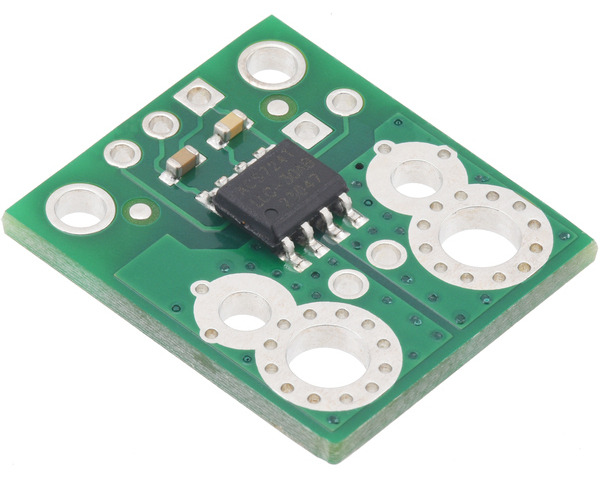

This is a merged information page for Item #4047.
View normal product page.
Pololu item #:
4047
Brand:
Pololu
Status:
Active and Preferred

This board is a simple compact carrier of Allegro’s ACS724LLCTR-30AB Hall effect-based, electrically isolated current sensor, which offers a low-resistance (~1.2 mΩ) current path and a high 120 kHz bandwidth for fast response times.
| Part Suffix | Range | Sensitivity @ 5 V | Zero Point @ 5 V | Supply Voltage |
|---|---|---|---|---|
| 30AB | ±30 A (bidirectional) | 66 mV/A | 2.5 V | 4.5 V to 5.5 V |
Alternatives available with variations in these parameter(s): current range Select variant…
 Compare all products in ACS724 Current Sensor Carriers.
Compare all products in ACS724 Current Sensor Carriers.
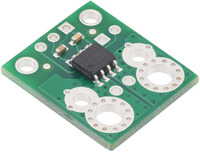 |
ACS724LLCTR-30AB Current Sensor Carrier -30A to +30A. |
|---|
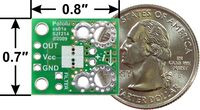 |
ACS724 current sensor carrier, bottom view with dimensions. |
|---|
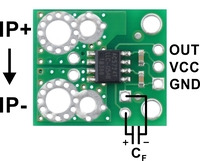 |
ACS724 Current Sensor Carrier pinout. |
|---|
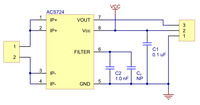 |
Schematic diagram of the ACS724 Current Sensor Carrier. |
|---|
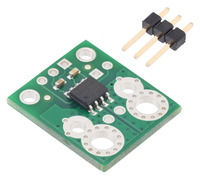 |
ACS724LLCTR-30AB Current Sensor Carrier -30A to +30A with included 0.1″ header pins. |
|---|
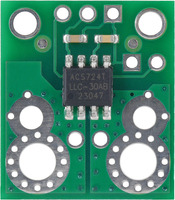 |
ACS724LLCTR-30AB Current Sensor Carrier -30A to +30A, top view. |
|---|
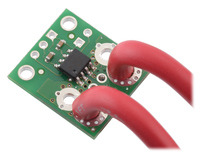 |
Current sensor carrier soldered with high-current wires. |
|---|
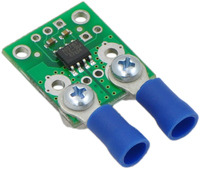 |
Current sensor carrier with solderless ring terminal connectors (not included). |
|---|
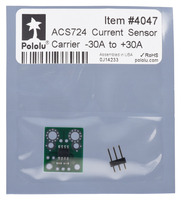 |
Standard packaging for the ACS724LLCTR-30AB Current Sensor Carrier -30A to +30A. |
|---|
 |
 |
We are offering these breakout boards with support from Allegro Microsystems as an easy way to use or evaluate their ACS724LLCTR Hall effect-based, electrically isolated current sensors; we therefore recommend careful reading of the ACS724 datasheet before using this product. The following list details some of the sensor’s key features:
The pads are labeled on the bottom silkscreen, as shown in the picture to the right. The silkscreen also shows the direction that is interpreted as positive current flow via the +i arrow.
A variety of options are available with different current sensing ranges and sensitivities:
| ACS724 Current Sensor Carriers | ||
|---|---|---|
| Sensitivity(1) | Unidirectional range | Bidirectional range |
| 800 mV/A | 0A to 5A | -2.5A to +2.5A |
| 400 mV/A | 0A to 10A | -5A to +5A |
| 200 mV/A | 0A to 20A | -10A to +10A |
| 133 mV/A | 0A to 30A | |
| 100 mV/A | -20A to +20A | |
| 66 mV/A | -30A to +30A | |
| 40 mV/A | -50A to +50A | |
| 1 Sensitivity shown for Vcc = 5V. | ||
Alternatives available with variations in these parameter(s): current range Select variant…
These versions all look very similar, and while you can distinguish them by reading the text on the IC, we also provide a white box on the bottom silkscreen where you can add your own distinguishing markings if so desired.
|
|
This carrier features the ACS724LLCTR-30AB, which operates at 5 V and is designed for bidirectional input current from -30 A to +30 A. This version can be visually distinguished from the other versions by the “30AB” written on the IC as shown in the pictures above.
| Part Suffix | Range | Sensitivity @ 5 V | Zero Point @ 5 V | Supply Voltage |
|---|---|---|---|---|
| 30AB | ±30 A (bidirectional) | 66 mV/A | 2.5 V | 4.5 V to 5.5 V |
When Vcc is 5 V, the output voltage is centered at 2.5 V and changes by 66 mV per amp of input current, with positive current increasing the output voltage and negative current decreasing the output voltage. More generally, the sensor’s zero point and sensitivity depend on VCC as follows:
``text(Zero Point) = V_"CC" / 2``
``text(Sensitivity) = 0.066 text(V)/text(A) * (1 + ((V_"CC" – 5 text(V)) * 1.3) / (5 text(V)))``
This board ships assembled with all surface mount components, and a 3×1 strip of 0.1″ header pins is included but not soldered in.
 |
This sensor has five required connections: the input current (IP+ and IP-), logic power (VCC and GND), and the sensor output (VIOUT).
The sensor requires a supply voltage of 4.5 V to 5.5 V to be connected across the VCC and GND pads, which are labeled on the bottom silkscreen, and the sensor outputs an analog voltage with a linear relationship to the input current:
``V_"IOUT" = text(Zero Point) + text(Sensitivity) * I_"P"``
``I_"P" = (V_"IOUT" – text(Zero Point)) / text(Sensitivity)``
The FILTER pin lets you adjust the board’s bandwidth by adding a capacitor to ground (a ground pad has been added next to the FILTER pin for convenience) in parallel with the 1 nF capacitor that is already on the board. Without an added external filter capacitor, the bandwidth is about 90 kHz. The datasheet provides more information on how the filter capacitors affect bandwidth.
You can insert the board into your current path in a variety of ways. For low-current applications, you can solder 0.1″ male header pins to the board via the smallest pair of through-holes on the input-current side of the board. For higher-current applications, you can solder wires directly to the through-holes that best match your wires, or you can use solderless ring terminal connectors. The largest through-holes are big enough for 8 AWG wires or #6 or M3.5 screws, and the second-largest through-holes (and mounting holes) are sized for 12 AWG wires or #2 or M2 screws.
|
|
Warning: This product is intended for use below 30 V. Working with higher voltages can be extremely dangerous and should only be attempted by qualified individuals with appropriate equipment and experience.
 |
Schematic diagram of the ACS724 Current Sensor Carrier. |
|---|
The dimension diagram is available as a downloadable PDF (1MB pdf).
We have a variety of current sensors available with different ranges, sensitivities, and features. The table below summarizes our selection of active and preferred options:
 |
 |
 |
 |
 |
 |
 |
 |
 |
 |
 |
 |
 |
|
|---|---|---|---|---|---|---|---|---|---|---|---|---|---|
| ACS37041 Current Sensor Micro Carriers |
ACS37041 Current Sensor Compact Carriers |
ACS711 Current Sensor Carriers |
ACS71240 Current Sensor Carriers |
ACS724 Current Sensor Carriers |
ACS37220 Current Sensor Compact Carriers |
ACS37220 Current Sensor Large Carriers |
ACS37030 Current Sensor Compact Carriers |
ACS37030 Current Sensor Large Carriers |
ACS72981 Current Sensor Compact Carriers |
ACS72981 Current Sensor Large Carriers |
CT432/CT433 TMR Current Sensor Compact Carriers |
CT432/CT433 TMR Current Sensor Large Carriers |
|
| Allegro Sensor | ACS37041 | ACS711KEXT | ACS71240 | ACS724LLCTR | ACS37220 | ACS37030 | ACS72981xLR | CT432/CT433 | |||||
| Sensing technology | Hall effect | Hall effect | Hall effect | Hall effect | Hall effect | Hall effect + inductive coil | Hall effect | XtremeSense™ TMR (tunneling magnetoresistance) |
|||||
| Logic voltage range | 3.3V versions: 3.0–3.6 V 5V versions: 4.75–5.5 V |
3.0–5.5 V | 3.3V ver: 3.0–3.6 V 5V ver: 4.5–5.5 V |
4.5–5.5 V | 3.3V versions: 3.15–3.45 V 5V versions: 4.5–5.5 V |
3.0–3.6 V | 3.3V versions: 3.0–3.6 V 5V versions: 4.5–5.5 V |
3.3V versions: 3.0–3.6 V 5V versions: 4.75–5.5 V |
|||||
| Family current range | 10–30 A | 15.5–31 A | 10–50 A | 2.5–50 A | 100–200 A | 20–65 A | 50–200 A | 20–70 A | |||||
| Current range/ sensitivity of individual versions |
3.3V Bidirectional: ±30 A / 44 mV/A 5V Bidirectional: ±10 A / 200 mV/A ±30 A / 66.7 mV/A |
3.3V Bidirectional: ±30 A / 44 mV/A 5V Bidirectional: ±10 A / 200 mV/A ±30 A / 66.7 mV/A |
Bidirectional:(1) ±15.5 A / 90 mV/A ±31 A / 45 mV/A |
3.3V Bidirectional: ±10 A / 132 mV/A ±30 A / 44 mV/A ±50 A / 26.4 mV/A 5V Bidirectional: ±10 A / 200 mV/A ±30 A / 66 mV/A ±50 A / 40 mV/A 5V Unidirectional: 0–50 A / 80 mv/A |
5V Bidirectional:(2) ±2.5 A / 800 mV/A ±5 A / 400 mV/A ±10 A / 200 mV/A ±20 A / 100 mV/A ±30 A / 66 mV/A ±50 A / 40 mV/A 5V Unidirectional:(2) 0–5 A / 800 mv/A 0–10 A / 400 mv/A 0–20 A / 200 mv/A 0–30 A / 133 mV/A |
3.3V Bidirectional: ±100 A / 13.2 mV/A ±150 A / 8.8 mV/A 5V Bidirectional: ±100 A / 20 mV/A ±150 A / 13.3 mV/A ±200 A / 10 mV/A |
3.3V Bidirectional: ±100 A / 13.2 mV/A ±150 A / 8.8 mV/A 5V Bidirectional: ±100 A / 20 mV/A ±150 A / 13.3 mV/A ±200 A / 10 mV/A |
3.3V Bidirectional: ±20 A / 66 mV/A ±65 A / 20.3 mV/A |
3.3V Bidirectional: ±65 A / 20.3 mV/A |
3.3V Bidirectional:(1) ±50 A / 26.4 mV/A ±100 A / 13.2 mV/A ±150 A / 8.8 mV/A ±200 A / 6.6 mV/A 3.3V Unidirectional:(1) 0–50 A / 52.8 mv/A 0–100 A / 26.4 mv/A 0–150 A / 17.6 mv/A 0–200 A / 13.2 mv/A 5V Bidirectional:(2) ±50 A / 40 mV/A ±100 A / 20 mV/A ±150 A / 13.3 mV/A ±200 A / 10 mV/A 5V Unidirectional:(2) 0–50 A / 80 mv/A 0–100 A / 40 mv/A 0–150 A / 26.7 mv/A |
3.3V Bidirectional:(1) ±50 A / 26.4 mV/A ±100 A / 13.2 mV/A ±150 A / 8.8 mV/A ±200 A / 6.6 mV/A 3.3V Unidirectional:(1) 0–50 A / 52.8 mv/A 0–100 A / 26.4 mv/A 0–150 A / 17.6 mv/A 0–200 A / 13.2 mv/A 5V Bidirectional:(2) ±50 A / 40 mV/A ±100 A / 20 mV/A ±150 A / 13.3 mV/A ±200 A / 10 mV/A 5V Unidirectional:(2) 0–50 A / 80 mv/A 0–100 A / 40 mv/A 0–150 A / 26.7 mv/A |
3.3V Bidirectional: ±20 A / 50 mV/A ±30 A / 33.3 mV/A ±50 A / 20 mV/A ±70 A / 14.3 mV/A 3.3V Unidirectional: 0–20 A / 100 mv/A 0–30 A / 66.7 mv/A 0–50 A / 40 mv/A 0–65 A / 30.8 mv/A 5V Bidirectional: ±20 A / 100 mV/A ±30 A / 66.7 mV/A ±50 A / 40 mV/A ±65 A / 30.8 mV/A 5V Unidirectional: 0–20 A / 200 mv/A 0–30 A / 133.3 mv/A 0–50 A / 80 mv/A 0–70 A / 57.1 mv/A |
3.3V Bidirectional: ±50 A / 20 mV/A ±70 A / 14.3 mV/A 3.3V Unidirectional: 0–50 A / 40 mv/A 0–65 A / 30.8 mv/A 5V Bidirectional: ±50 A / 40 mV/A ±65 A / 30.8 mV/A 5V Unidirectional: 0–50 A / 80 mv/A 0–70 A / 57.1 mv/A |
| IC current path resistance | 1.6 mΩ | 0.6 mΩ | 0.6 mΩ | 0.6 mΩ | 0.1 mΩ | 0.7 mΩ | 0.2 mΩ | 1 mΩ | |||||
| PCB | 2 layers, 1-oz copper |
2 layers, 2-oz copper |
2 layers, 2-oz copper |
2 layers, 2-oz copper |
2 layers, 2- or 4-oz copper(4) |
2 layers, 2-oz copper |
6 layers, 2-oz copper |
2 layers, 2-oz copper |
6 layers, 2-oz copper |
6 layers, 2-oz copper |
6 layers, 2-oz copper |
2 or 4 layers(5), 2-oz copper |
6 layers, 2-oz copper |
| Max bandwidth | 150 kHz | 100 kHz | 120 kHz | 120 kHz(3) | 150 kHz | 5 MHz | 250 kHz | 1 MHz | |||||
| Size | 0.3″ × 0.4″ | 0.7″ × 0.8″ | 0.7″ × 0.8″ | 0.7″ × 0.8″ | 0.7″ × 0.8″ | 0.7″ × 0.8″ | 1.4″ × 1.2″ | 0.7″ × 0.8″ | 1.4″ × 1.2″ | 0.7″ × 0.8″ | 1.4″ × 1.2″ | 0.8″ × 1.1″ | 1.4″ × 1.2″ |
| Overcurrent fault output |
User-configurable threshold | ||||||||||||
| Common-mode field rejection | |||||||||||||
| Nonratiometric output | |||||||||||||
| 1-piece price | $3.65 | $3.95 | $4.35 | $4.75 | $8.95 – $10.49 | $5.95 | $8.95 | $9.95 | $12.95 | $11.95 | $14.95 | $10.95 | $14.95 |
Note 1: Sensitivity when Vcc = 3.3 V; actual sensitivity is ratiometric (i.e. it is proportional to Vcc).
Note 2: Sensitivity when Vcc = 5 V; actual sensitivity is ratiometric (i.e. it is proportional to Vcc).
Note 3: Bandwidth can be reduced by adding a filter capacitor.
Note 4: 50A version uses 4-oz copper PCB; all other versions use 2-oz copper.
Note 5: 50A and higher versions use a 4-layer PCB; all other versions use a 2-layer PCB.
You can also use the following selection box to see all these options sorted by current range:
Alternatives available with variations in these parameter(s): current range Select variant…
| Size: | 0.7″ × 0.8″ |
|---|---|
| Weight: | 1.1 g |
| Current sense: | 66 mV/A1 |
|---|---|
| Minimum logic voltage: | 4.5 V |
| Maximum logic voltage: | 5.5 V |
| Supply current: | 14 mA2 |
| Current range: | -30A to +30A (bidirectional 30A), 5V |
| Current sensor: | Allegro ACS724LLCTR-30AB |
| PCB dev codes: | cs01a |
|---|---|
| Other PCB markings: | 0J1214, blank white box |
This DXF drawing shows the locations of all of the board’s holes. The through-hole sizes and locations in this file also apply to cs01b versions of the PCB, though some of the via locations are different.
This is the application note referenced on page 16 of the ACS724 datasheet, page 22 of the ACS71240 datasheet, and page 42 of the ACS72981xLR datasheet. The ACS720 is used validate the test methods presented, but these same methods and principles would also apply to the ACS724, ACS71240, and ACS72981.
Allegro product page for the ACS724, where you can find additional application notes and other resources.
No FAQs available.
No blog posts to show.